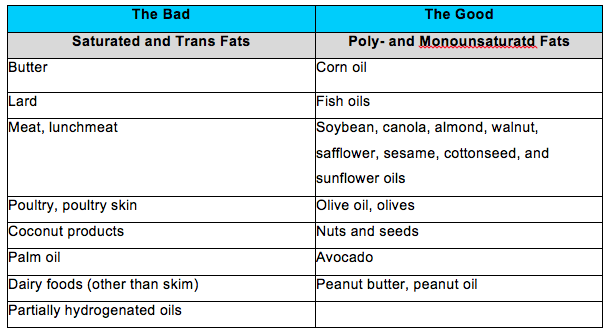Unhealthy vs. Healthy Fats: Why not all fat is bad for you
Fat free diets. Fat free foods. For years, fat free fanatics have suffered from fat free mania, desperately trying to avoid any fat in their diets out of a belief that a fat free lifestyle is a guaranteed weight loss strategy. What many fat fearing dieters may not realize, however, is that our bodies need a healthy level of fat in order to maintain overall wellness. As a matter of fact, The United States Department of Agriculture recommends that adults get 20 – 35 percent of their total calories from fats. Fats provide essential fatty acids, offer fat-soluble vitamins, and are an important source of energy. It’s important to understand that there are different types of fats, and that some are healthier for you than others. Instead of trying to live a completely fat-fee lifestyle, simply knowing the different sources of good and bad fats, and what constitutes a healthy amount of each, can truly help you meet your weight loss goals.
The Good
Unsaturated fats are considered good fats. They include polyunsaturated fatty acids and monounsaturated fats. When eaten in moderation, our bodies use mono- and polyunsaturated fats to replace unhealthy fats, such as saturated or trans fats, a process that can help lower cholesterol and reduce our risk of heart disease. Omega-3 fatty acids are a specific type of good fat that offer healthy benefits for our hearts. Found in fatty fish such as salmon, trout, catfish, and mackerel, as well as flaxseeds and walnuts, The American Heart Association recommends eating two servings of these polyunsaturated fats each week, preferably in the form of fatty fish. While omega-3 supplements are available, it is healthiest to obtain the nutrient from food sources, rather than from vitamin supplements.
Monounsaturated fats are another form of good fat that can help prevent heart disease. Most commonly found in olive oil, avocados, hazelnuts, almonds, Brazil nuts, cashews, sesame seeds, pumpkin seeds, canola, oil and peanut oil, these healthy fats are a good source of vitamin E.
The Bad
Saturated and trans fatty acids are the unhealthy fats that should only be eaten sparingly. These bad fats can raise cholesterol levels, clog arteries, and increase the risk of heart disease, colon cancer, and prostate cancer. Saturated fats are most commonly found in animal products such as meat, poultry skin, high-fat dairy and eggs, and some vegetable fats such as coconut and palm oils.
Trans fats come in two forms: the kind that is naturally occurring and can be found in small amounts in some dairy and meat, and the kind that is artificial and that occurs when liquid oils are hardened into “partially hydrogenated” fats.
The Ugly
Artificial trans fats are having the greatest negative impact on the average American diet. Typically used in the preparation of fried foods, baked goods, cookies, icings, crackers, and packaged snack foods, experts warn that artificial trans fats are even more detrimental to our health than butter or lard. Even small amounts of artificial trans facts can increase our risk of heart disease.
Still confused? Use the chart below to identify good and bad fats so that you can incorporate the proper amounts of each in your healthy diet:
More

